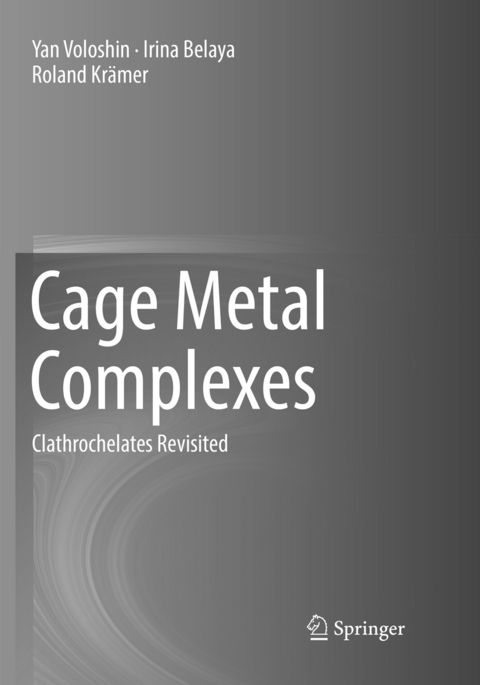
Cage Metal Complexes
Springer International Publishing (Verlag)
978-3-319-85910-1 (ISBN)
This fundamental book presents the most comprehensive summary of the current state in chemistry of cage metal complexes. After their previous book "The Encapsulation Phenomenon" (www.springer.com/978-3-319-27737-0) the authors in this book focus on the encapsulation of metal ions by different types of three-dimensional mono- and polynucleating caging ligands. Within these cage metal complexes, (metal) ions can be isolated from external factors.
The book provides both a classification of the cage compounds and summaries of synthetic approaches. On that basis the authors then describe the unique chemical and physical properties and the resulting reactivity of the cage compounds, as well as practical and potential applications as potent topological drugs and prodrugs, antifibrillogenic agents, radiodiagnostic and radiotherapeutic compounds, paramagnetic probes, single-molecule magnets, electrocatalysts for hydrogen production, (photo)electronic devices, and many more.
Readers will find a well-structured and concise overview, with particular emphasis on a review of synthesis and reactivity of various cage metal complexes, summarizing over 400 literature references, clearly presented in over 300 color schemes and figures.Prof. Dr. Yan Voloshin is Full Professor in Inorganic Chemistry at the Nesmeyanov Institute of Organoelement Compounds of the Russian Academy of Sciences, and the Head of the laboratory of aliphatic organoboron compounds, as well as Full Professor at the Kurnakov Institute of General and Inorganic Chemistry, Russian Academy of Sciences & Gubkin Russian State University of Oil and Gas, Moscow, Russia. He obtained his M.Sc. in 1985 from the Kiev National Shevchenko University, Department of Chemistry, and a PhD from the Vernadskii Institute of General and Inorganic Chemistry, National Academy of Sciences of Ukraine in 1988, as well as the degree of Doctor of Sciences from the Institute of Solution Chemistry of the Russian Academy of Sciences in 1994. He was the Head of the laboratory of metal complex catalysis at the Karpov Institute of Physical Chemistry in Moscow (1991-2010). His research interests focus on coordination chemistry, supramolecular chemistry, bioinorganic chemistry, hydrogen energetics and production, macrocyclic chemistry, cage metal complexes, clathrochelates, nanochemistry, and topological drugs. Dr. Irina G. Belaya is a research fellow at the Nesmeyanov Institute of Organoelement Compounds of the Russian Academy of Sciences, Moscow, Russia. Her research interests center around coordination chemistry, macrocyclic compounds, cage complexes. Dr. Belaya studied chemistry and obtained her M.S. at The Higher Chemical College of the Russian Academy of Sciences, Moscow, Russia. She received her PhD in 2013 from the Nesmeyanov Institute of Organoelement Compounds of the Russian Academy of Sciences. Prof. Dr. Roland Krämer is full professor at the University of Heidelberg, the Faculty of Chemistry and Geosciences, Institute of Inorganic Chemistry. He studied chemistry at Technical University of Karlsruhe and University of München, where he also obtained his PhD degree for research on Organotransition metal complexes of amino acids, peptides and their derivatives in 1991. He then joined the group of J.-M. Lehn in Strasbourg for postdoctoral research, before starting his habilitation in Münster (1993-1997). Prof. Krämer was guest scientist at University of Vienna and took a sabbatical in the chemical industry (Henkel KgaA, Düsseldorf), working on bleaching catalysts for detergents. In 1998, he became Professor at University of Münster, accepted (partially in parallel) a position as Assistant Professor at University of Mainz, and then moved to Heidelberg as Full Professor in 1999.
Introduction, and General considerations.- Synthesis and reactivity of cage metal complexes.- Spatial and electronic structure of cage metal complexes.- Magnetic and redox properties of cage metal complexes.- Practical applications of cage metal complexes.
| Erscheint lt. Verlag | 31.7.2018 |
|---|---|
| Zusatzinfo | XI, 467 p. 705 illus., 73 illus. in color. |
| Verlagsort | Cham |
| Sprache | englisch |
| Maße | 178 x 254 mm |
| Gewicht | 1226 g |
| Themenwelt | Naturwissenschaften ► Chemie ► Anorganische Chemie |
| Schlagworte | Antifibrillogenic activity • cage compounds • Caging ligands • Cation encapsulation • Clathrochelates • drug design • Functional biomimetics • Macrocyclic compounds • Paramagnetic probes • Polynuclear metal complexes • Radiotherapeutic cage complexes • Single-Molecule Magnets • Template synthesis • Topological drugs |
| ISBN-10 | 3-319-85910-2 / 3319859102 |
| ISBN-13 | 978-3-319-85910-1 / 9783319859101 |
| Zustand | Neuware |
| Haben Sie eine Frage zum Produkt? |
aus dem Bereich


